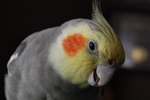Things You'll Need
A Bourke's parakeet, preferably young.
Your bird's favorite treat (try millet spray)
Consistent training techniques, applied daily
Bourke's parakeet (neophema bourkii) is a small grass parakeet originally from Australia. Not to be confused with the popular budgerigar, commonly called a parakeet or budgie in the United States, a Bourke's parakeet is a smaller bird with a more reserved nature. Typically kept in groups as aviary birds, training experiences can vary according to the age and temperament of your bird.
The Bourke's is about 6 inches long including its tail. Its colors (as shown in the photo) are a combination of muted brown, gray, pink, white with accents of violet blue. The bird's large dark eyes give it a gentle appearance, and it's quiet twittering sounds won't disturb the most sensitive of ears. Bred in captivity for many years, the Bourke's parakeet is also available in a pink mutation known as the Rosey Bourke's.
Typically sold and kept as aviary birds, the Bourke's is not usually kept caged as a pet, but young Bourke's parakeets can be hand-fed and will readily attach to their human "parent." If you're lucky enough to find a hand-fed baby Bourke's, you won't need to do much training as the bird will want to be near you (or perched on you) given the opportunity.
If you want to tame a Bourke's parakeet, here are some tips for training your pet to step up on your finger.
After allowing your Bourke's parakeet a day or two to get settled in its new home, you can begin taming the bird by speaking gently to it several times a day. Move slowly and quietly around your bird, so it won't startle. You want to gain your bird's confidence. Watch your bird's body language; if it comes close to you, that's a great start, but it may retreat to a corner of the cage. Another sign of fright is a horizontal posture that indicates that your Bourke's is ready to launch into flight. If your bird flutters around in the cage, step back as the bird can injure itself as it thrashes around. This may occur if the bird was raised in a large aviary and is not used to living in a smaller cage..
Discover your bird's favorite treat. Bourke's are from a family of birds that enjoy grass seed, and spray millet seed sold in pet stores (birdseed on the stem) is often a great favorite. Hold some millet in your open palm as you open the cage and gently insert your hand. Hold your hand open with the treat, and don't attempt to touch the bird or move your hand toward it. It may take a few days of this before your bird gets used to your hand. It's unlikely that your bird will alight on your hand and take the treat; your goal is for your bird to get used to your hand and understand that you won't harm it. When you can consistently place your hand in the cage with the bird staying calm, it's time to move to the next step.
Now that your Bourke's parakeet has gained your trust (and recognizes you as the bearer of treats), it's time to gently approach the bird while it's in its cage. Hold your index finger out horizontally and slowly approach your bird. It will probably look at your finger, move its head in either direction looking for an escape. If the bird flees from your hand, don't try to approach it. Just keep your hand steady within the cage, and talk gently to your bird. Once it settles down, try again. You may offer a treat to remind the bird that your hand is a good thing. Your goal is to gently press your index finger against your bird's chest just above its feet. As you do this, say (in a cheerful, high-pitched tone) "Step up." The bird will either back away or step up. If it steps up, praise it and keep still for a moment. If the bird jumps off of your finger, give it a moment and repeat the process. Eventually, the bird will step up when you present your index finger as a perch.
Once your bird readily steps up on your finger within its cage, it's time to take it out of the cage on your finger. (Read the safety tips before attempting to remove your bird from its cage.) It's best to start out in a small room with few or no windows. bathrooms are ideal, but make sure that the lid on the commode is closed Ask your bird to "step up," and when it does, gently remove your bird from the cage. If it takes off, go to where it lands and ask it to step up. If it does, you can congratulate yourself on having hand-tamed a Bourke's parakeet. If the bird flees in fright or confusion, you may need to lower the lights and gently retrieve the bird, holding it so that it can't bolt in the dark. Speak gently to your bird as you retrieve it. This process can take time, but eventually, your bird should learn to "step up" and stay on your finger.
Tips
Always move slowly and speak gently to your bird; birds are sensitive and will instinctively flee from perceived threats. Wing-clipping can save your bird's life. Wild Bourke's parakeets can fly many miles each day; pet birds kept indoors can easily gain enough speed to seriously injure or kill themselves if they crash into a wall or window. Ask your vet or bird supply store to show you how to clip your bird's wings. It doesn't hurt your bird and will help keep it safe when outside of its cage. Avoid tiring your pet. Birds enjoy the company of their owners, but it's a good idea to return your bird to its cage for a break every 30 minutes or so. Bourke's like to nap during the afternoon but will be perky and ready for company afterward.
Warnings
Don't let your Bourke's parakeet walk around on the floor. Birds are easily stepped on and your Bourke's small size and quiet nature can lead to an accident. Don't take your bird outdoors unless it's caged: Many tame birds have been lost after flying away outdoors. If your bird's wings are clipped, it may try to take off and fall to the ground within reach of dogs or cats. Some birds maintain a sruprising range of flight after their wings have been clipped; taking your Bourke's outdoors without the shelter of its cage is just too risky. Don't trust your Bourke's with other pet birds. Unless you're keeping a community of similar sized birds in an aviary, it's best to avoid letting pet birds of differing species mingle. Birds can be territorial and protective of their "turf" and their mates, and can be aggressive toward one another.
Photo Credits
-
www.hscbemidji.org/images/australian_bourke.jpg





